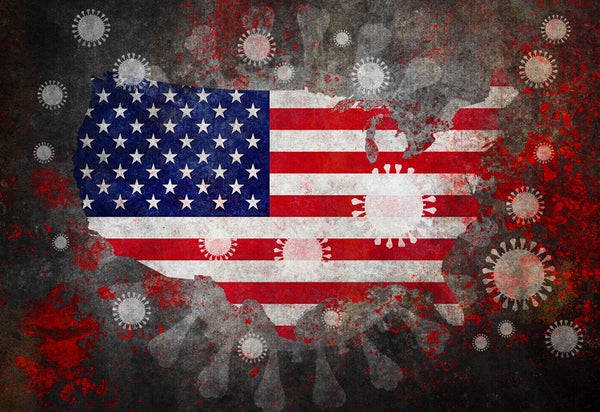The U.S. currently has the most confirmed COVID-19 infections of any country, with more than 203,000 cases as of Wednesday. New York City has emerged as the outbreak’s newest focal point, with more than 44,900 people testing positive as of that time.And major outbreaks are underway in cities such as Seattle and New Orleans. But state-level data may be hiding hotspots in less populous areas.
Now a team from the University of Chicago has mapped confirmed COVID-19 infections per county—and has adjusted for population sizes. The researchers’ findings reveal significant clusters in parts of Georgia, Arkansas and Mississippi, among other areas. Even though the involved populations may be smaller than those of New York or Seattle, they could be disproportionally hit by the disease.
“When you flip from just state-level data to county-level data, you get a lot more information,” says Marynia Kolak, assistant director of health informatics at the University of Chicago’s Center for Spatial Data Science, who co-led the team that created the maps. “For example, there are a lot of areas in the South where the population is a lot smaller, but the proportion of people who have [COVID-19] is a lot greater. So that can cause potential challenges, because even though there are less people who have the virus, there are also correspondingly fewer hospital beds, [intensive care units] or ventilators.”
On supporting science journalism
If you're enjoying this article, consider supporting our award-winning journalism by subscribing. By purchasing a subscription you are helping to ensure the future of impactful stories about the discoveries and ideas shaping our world today.
The mapping team initially used data from a crowd-sourced tracker of county-level cases and validated them with estimates from state health departments. The researchers have since incorporated data from several other sources, and they are partnering with their colleagues at the University of Wisconsin–Madison to authenticate that information. The University of Chicago group compiled data on both state and county levels, looking at each area’s confirmed cases, deaths and number of cases weighted by population size. The team also created an interactive visualization that shows the evolution of regional hotspots over time.
.png?w=900)
Credit: Amanda Montañez; Source: Marynia Kolak, Xun Li and Qinyun Lin Center for Spatial Data Science, University of Chicago
The data reveal some surprising patterns in infection rates at the county level after adjusting for population size. For example, many county clusters—such as those around Albany, Ga., Detroit, Nashville, Tenn., and parts of Mississippi and Arkansas—had relatively large numbers of cases per capita. As of March 29, the county cluster encompassing New York State, New Jersey and Massachusetts still had the most confirmed infections both overall and per capita: 76,273 cases, or about 22 per 10,000 people. Yet Albany, Ga., had the second-highest number per capita: 13 cases per 10,000 people. That figure was much higher than those of other well-known hotspots, such as Seattle, which had about eight cases per 10,000, and San Francisco, which had two per 100,000.
“The big [outbreaks] that I was expecting to see, like Seattle or New York, I didn’t realize how widespread they were,” Kolak says. The Seattle hotspot, for instance, extends out to roughly half of Washington State. And “there are a lot of areas”—such as Albany, Ga.—“that I was really surprised about,” she adds.
Many of these more rural counties have had far fewer deaths overall, compared with large cities such as New York or Seattle, but higher relative death rates. The New York–New Jersey–Massachusetts area had a fatality rate of 1.4 percent, whereas that of Albany, Ga., was 7.65 percent (although these numbers almost certainly do not account for milder cases that were not tested). In several areas, hospital intensive care units are already reaching their capacities, Kolak says. Not only do some of these places have fewer resources, many of them are also in states that have not expanded Medicaid, so residents already have less access to affordable health care. In addition, according to the researchers, a lot of people in the rural, southern parts of the country tend to be older and have more underlying health conditions, which have been linked to more deadly COVID-19 infections.
Another issue is the rate of spread. Health authorities might be less alarmed about a relatively small hotspot if this illness was a slowly developing chronic one, such as heart disease. But because the novel coronavirus is highly contagious and spreads so rapidly, the numbers can increase very quickly. “Within the day it took to write up the report, the cluster in Mississippi doubled,” Kolak notes. “And then it doubled again.” In terms of the rate of new infections, New Orleans, Detroit and Chicago are also very concerning.
Given the shortage of testing capacity in the U.S., some areas simply may not know the extent of their outbreaks. New York State has been testing pretty aggressively. Smaller county clusters, however, may lack the resources to do so. Kolak acknowledges that she and her colleagues are only looking at confirmed cases, but comparing the numbers in these hotspots with those in surrounding areas does provide a sense of the outbreaks’ relative severity. The team has started working with other research groups to validate the accuracy of its data, Kolak says. And the next step will be collaborating with health groups around the country to determine what information would be most useful to them.
The new findings could have critical implications for controlling the spread of the virus. One of the main take-home messages, Kolak says, is the importance of policies on social distancing and isolating each outbreak before it gets more serious. “Rather than wait for it to get so extreme that, you know, the whole state emerges as a hotspot,” she says, “try to contain it within a county before it goes further.”
Read more about the coronavirus outbreak here.
